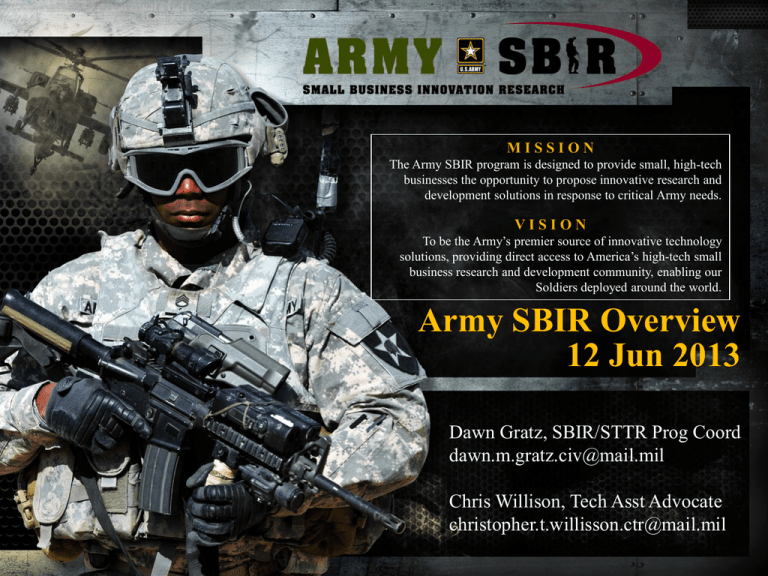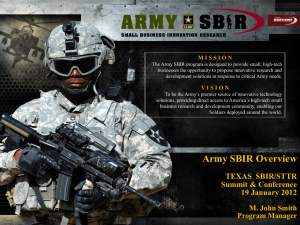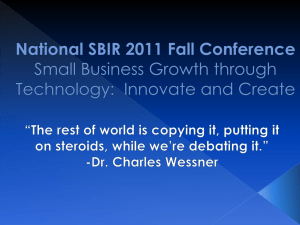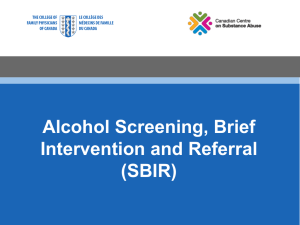Dawn M. Gratz, AMRDEC SBIR and STTR Programs Coordinator
advertisement

MISSION The Army SBIR program is designed to provide small, high-tech businesses the opportunity to propose innovative research and development solutions in response to critical Army needs. VISION To be the Army’s premier source of innovative technology solutions, providing direct access to America’s high-tech small business research and development community, enabling our Soldiers deployed around the world. Army SBIR Overview 12 Jun 2013 Dawn Gratz, SBIR/STTR Prog Coord dawn.m.gratz.civ@mail.mil Chris Willison, Tech Asst Advocate christopher.t.willisson.ctr@mail.mil What is SBIR? A congressionally mandated program… • Across Federal Government (DoD, DoE, DHS, • • • DoT, etc…) Title 15 USC, Sec 638 2.6% of Army’s FY12 RDT&E budget ($182M) Increase small business participation in federally funded R&D Transition Federal R&D into: – Government Programs – Industry Initiatives Army wide: AMC, Research Development and Engineering Command (RDECOM) Army Test and Evaluation Command (ATEC) CoE, Engineer Research and Development Center (ERDC) MEDCOM, Medical Research and Materiel Command (MRMC) Space & Missile Defense Command (SMDC) DA G1, Army Research Institute (ARI) Army Program Executive Offices (PEOs) 2 DISTRIBUTION STATEMENT A. Approved for public release; distribution is unlimited. 2 SBIR Program Requirements for Participating Small Businesses Small Business Innovation Research (SBIR) Business Size Partnering Budget Must be a U.S. for-profit small business of 500 or fewer employees Not required, but all work must be performed in the United States; including subcontractors ~$180M Work Effort In Phase I, a minimum of 2/3 of the effort must be performed by the proposing small business; a minimum of ½ of the effort in Phase II Principal Investigator The Principal Investigator must spend more than ½ of the time employed by the proposing small business 3 ARMY SBIR Life Cycle • Transition is program maturation from SBIR investment to Non-SBIR government and/or commercial investment Phase II Phase I Topics A Technology Requirement Written by Army Scientists across the Labs, Centers and PEOs in response to Soldier’s Needs Feasibility Study A short term effort to determine viability of a topic solution (6 months, $100K) 3000 proposals, 400 PhI awards (13%) Phase I Option $50K when selected for PhII Prototype Development Creation of a prototype to validate & mature the topic solution (2 years, $1.0M) 200 PhIs Awarded Contracts (6%) Army SBIR Small Business Innovation Research Soldier Needs R&D / Innovation / New Capability SID-TFT Capability Gaps PEO Roadmaps/T2 Initiatives DoD Cross-Pollination Opportunities ~3000 Proposals per FY ~630 Awards per FY 3 DoD Topic Solicitations Soldier Solutions Increased Operational Capabilities Output to Field Input from Field Commercialization Readiness Program (CRP, $500K) Phase II Enhancements (PhII-E, $500K) Phase III Transition Non-SBIR Funds • Government • Industry Recent History 2005 2006 2007 2008 2009 2010 2011 2012* Budget ($M) $233 $243 $243 $270 $265 $244 $207 $182 # Topics 246 238 216 204 176 138 119 # Phase I Proposals Received 4,503 3,794 # Phase I Contracts 371 321 361 409 427 336 363 132 # Phase II Contracts 259 218 185 255 204 177 200 41 10 $5 32 $19 34 $16 52 $33 33 $21 25 $15 25 $15 25 $15 9 $8 3,142 3,110 3,449 3,241 2,853 # Phase II Enhancements Funds Invested ($M) # CRP Projects Funds Invested ($M) 213 25 $15 2,140 * In Progress Topic Author Organizations Organization 2011 Topics ARI ARL AMRDEC (A) AMRDEC (M) ARDEC ATEC CERDEC ECBC ERDC MRMC NSRDEC SMDC STTC TARDEC PEO AMMO PEO AVIATION PEO C3T JPEO-CBD PEO CS&CSS PEO EIS PEO GCS PEO IEW&S PEO M&S PEO SOLDIER PEO STRI PEO Integration Total N/A 16 8 9 14 3 25 2 3 13 8 8 1 12 1 2 1 2 2 N/A 2 1 3 2 1 N/A 139 TARDEC, PEOCS&CSS, PEO-GCS Warren, MI NSRDEC Natick, MA ARDEC. PEO-Ammo Picatinny, NJ CERDEC, PEO-C3T, PEO-EIS, PEO-IEW&S APG, MD ATEC, AMSAA APG, MD ARO (ARL) Raleigh, NC ERDC Vicksburg, MS AMRDEC - Missiles, SMDC,PEO-Aviation, PEO-Missiles&Space Huntsville, AL STTC (ARL), PEO-STRI Orlando, FL Headquarters RDECOM – Aberdeen Proving Ground, MD AMRDEC – Aviation & Missile Research, Development & Engineering Center ARDEC – Armaments Research, Development & Engineering Center ARL – Army Research Lab ARO – Army Research Office CERDEC – Communication-Electronics Research, Development & Engineering Center ECBC – Edgewood Chemical Biological Center NSRDEC – Natick Soldier Research, Development & Engineering Center STTC – Simulation and Training Technology Center TARDEC – Tank Automotive Research, Development & Engineering Center HQ RDECOM (APG, MD) ECBC APG, MD ARL Adelphi , MD MRMC Ft Detrick, MD AMRDEC - Aviation Fort Eustis, VA ARI Arlington, VA PEO-Soldier, Fort Belvoir, VA SBIR Program Coordinators SBIR Program Office RDECOM AMRDEC Dawn Gratz - Lead Linda Taylor - Aviation Buddy Thomas - Missile ARDEC Carol L’ Hommedieu- Lead Ben Call ARL Christopher Little CERDEC Pat Thomas- Lead ECBC Dhirajlal Parekh- Lead Martha Weeks NSRDEC-Natick Cathy Polito-Lead TARDEC Martin Novak- Lead Headquarters RDECOM John Smith – Program Manager John Pucci – Operations Manager Wanda Deans – Business Manager PEOs PEOs PEO Ammunition Vince Matrisciano PEO CS &CSS Matt Raubinger PEO Aviation Dave Weller PEO EIS Michael Muller Dirk Robinson PEO C3T Thomas Brutosfsky Richard Lo PEO IEW&S Todd Simkins PEO GCS Michelle Link PEO Soldier Kristen McKenna PEO Missiles & Space Myron Chenault George Burruss PEO STRI Robert Forbis TRADOC* Albert Crane ATEC Nancy WeinbrennerSavage SMDC Gary Mayes LIA* Dale Houck ERDC Theresa Salls * LIA and TRADOC are Stakeholders but do not award any SBIR contracts MRMC JR Myers Army SBIR Source Selection Process • The Army conducts a two-tier evaluation of proposals. • Tier 1 consists of the Technical Evaluation Teams (TET) comprised of multiple Technical Evaluators and a Team Chief for each SBIR topic. Included is the review and endorsement of proposals by various Army stakeholders. The TET forwards the best proposals to the second review tier. • Tier 2 consists of the Technology Area Chiefs who review the forwarded proposals from an Army-wide perspective and together as the Source Selection Evaluation Board (SSEB) recommends those that merit consideration for funding. • Based on the SSEB recommendations, the Source Selection Authority (SSA) selects proposals that best satisfy Army needs. Proposals are evaluated using the following criteria (published in the Solicitation): 1. Technical feasibility 2. Strength of the personnel & facilities 3. Transition potential Phase II Enhancements • Purpose: To accelerate the transition to a useable technology. • Army SBIR Phase II Enhancement provides Phase II SBIR funding to firms that require additional funding during their open Phase II contract. • How? – Enhancement candidates are initially identified by the project’s COR. – COR has commitment from the customer to participate in the transition – The COR, in conjunction with the TAA and the organization’s PC will compile the documentation needed for PM, SBIR to make a determination. – Generally SBIR Phase II Enhancement funding will not exceed $500,000 per request and funding is subject to availability and a deliberate approval process. – Matching funds strongly encouraged. • Activities funded: – Further R&D – Modifying or building prototypes; delivering multiple copies – Other activities that facilitate the transition of the project to Phase III 9 Commercialization Readiness Program (CRP) • Assess Phase II projects’ commercial and transition potential against program objectives and recommend CRP participants to the Army (~25) – Commercialization and Transition Assessment (CTA) Forms – Once a year – May - June • Assist selected CRP participants with commercialization and transition – Marketing and business plan development – Facilitate customer collaboration – Co-develop technology transition plans and agreements – Support identification of 3rd party funding/investment opportunities • Recommend CRP participant funding levels to the Army ($500K) Ideally, funded as an extension to existing Phase II contract **** Projected plan 10 Transition Support • SBIR Transition Programs Available to Small Businesses: 1.Transition Assistance -- Collaboration/Networking with Army technologists and Transition Agents, such as PEOs/PMs -- Technology Transition Planning and Development -- Phase III Planning Assistance (Help formulate Strategies and Resource Requirements) 2. Phase II-Enhancement and Commercialization Readiness Program (CRP) -- Both initiatives are complementary; Each authorized by Congress or SBA Policy (Guidance reaffirmed in FY12 NDAA, 31 Dec 2011) -- Purpose: To accelerate the transition to a useable technology -- Provide < $500K Additional Funds To Active PhII firms during their open Phase II contract (Contract Modification) -- Candidates are identified by local SBIR PC Team, who assesses all Ph2 projects during 1 st year of contract performance • Promising technologies that will require activities after Year 2 prototype is delivered, are further evaluated for transition funds • Activities Funded: Further R&D, TRL Maturation, Prototype T&E, etc to facilitate transition to Phase III -- Funding is subject to availability and a deliberate approval process -- Funding commitments from transition partners is STRONGLY encouraged 11 SBIR Reauthorization Act (FY12 NDAA) • Extends Program Thru 30 Sep 2017 • Except For Annual Budget 0.1 % Increase, all other guidance dependent on SBA Policy Directive, ~30 Jun 12 • PhII contract size will be limited to < $1.5M (limits Ph2-E/CRP funds < $500K) • Annual 0.1% Budget Increases Until 3.2% Cap…Increases Are For Transition Only – – – FY12 Budget (2.6% of Army Extramural RDT&E): $182M (FY11 Budget: $204M, FY10 Budget: $244M) Less Projects…But Selected Projects will have greater opportunities for transition funds Future SBIR Topic Focus: 24 S&T Challenge Areas and PEO Tech Needs • Selections within 90 calendar days from the closing date of the solicitation. Award within 180 calendar days of the closing date of the solicitation (Army announces selections now in less than 90 days) • No Phase II Invitations; reauthorization also allows agencies the option to bypass the Phase I process (DoD will not implement bypassing Phase I) • DoD Optional: Provide funds to Venture Capital-backed Firms (DoD will not implement) 12 www.armysbir.army.mil 7 May 2009 13 Assistance 1. DoD SBIR Helpdesk (1-866-724-7457) 2. Army SBIR Helpdesk (703-399-2049) 3. During Pre-Solicitation Period, Topic Authors are available to answer questions put directly to them (www.dodsbir.net/solicitation/) 4. Once the Solicitation opens, firms may contact Topic Authors via SITIS: (http://www.dodsbir.net/sitis/) 5. Army AMRDEC, PEO AV, PEO MS Program Coordinator, and Technical Assistance Advocate 14







